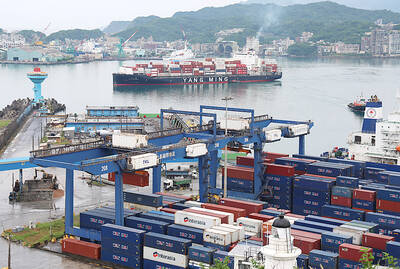Taiwan Ratings Corp (中華信評) yesterday said that the performance of its rating pool last year remained largely resilient to external challenges, albeit with a mild increase in negative bias in the second half.
“The majority of our ratings maintained a stable outlook throughout the year, even in the corporate sector, which experienced the heaviest impact from the tariff spat between the US and China,” the local arm of Standard & Poor’s (S&P) Global Ratings said in a report.
As a result, there was a slight increase in negative bias in the second half of last year, reflecting negative rating actions in the corporate sector as waning global demand created pressure on profitability and cash flow generation, it said.
Taiwan Ratings did not offer any upgrades for the corporate sector last year, but made three downgrades and six downward outlook revisions.
The financial services sector displayed a generally positive rating performance last year, leading Taiwan Ratings to upgrade six financial institutions, while downgrading two.
The upward actions mainly reflected prudent capital management and improved capitalization, it said.
Most structured financial transactions under its surveillance also showed a stable rating performance last year, supported by their conservative deal structure and steady counterparty support, despite asset performance volatility, Taiwan Ratings said.
The company downgraded a collateralized bond issuance due to the trustee’s failure to obtain a refund of a withheld tax from tax authorities, it said.
The credit quality of fixed-income funds were generally stable last year, despite continued yield competition, fluctuations in fund size, and the lower interest rate environment, which drove some fixed-income funds to pursue more aggressive investments, Taiwan Ratings said.
“We placed one fixed-income fund on credit watch with negative implications because of a compliance incident related to the fund company,” it said.
In all, Taiwan Ratings undertook six upward rating actions and five downward actions on rated entities in the nation’s financial and corporate sectors last year, it said.
The number of downgrades reached a three-year high, as there were no downgrades in the previous two years, it said.

The demise of the coal industry left the US’ Appalachian region in tatters, with lost jobs, spoiled water and countless kilometers of abandoned underground mines. Now entrepreneurs are eyeing the rural region with ambitious visions to rebuild its economy by converting old mines into solar power systems and data centers that could help fuel the increasing power demands of the artificial intelligence (AI) boom. One such project is underway by a non-profit team calling itself Energy DELTA (Discovery, Education, Learning and Technology Accelerator) Lab, which is looking to develop energy sources on about 26,305 hectares of old coal land in

Taiwan’s exports soared 56 percent year-on-year to an all-time high of US$64.05 billion last month, propelled by surging global demand for artificial intelligence (AI), high-performance computing and cloud service infrastructure, the Ministry of Finance said yesterday. Department of Statistics Director-General Beatrice Tsai (蔡美娜) called the figure an unexpected upside surprise, citing a wave of technology orders from overseas customers alongside the usual year-end shopping season for technology products. Growth is likely to remain strong this month, she said, projecting a 40 percent to 45 percent expansion on an annual basis. The outperformance could prompt the Directorate-General of Budget, Accounting and

Netflix on Friday faced fierce criticism over its blockbuster deal to acquire Warner Bros Discovery. The streaming giant is already viewed as a pariah in some Hollywood circles, largely due to its reluctance to release content in theaters and its disruption of traditional industry practices. As Netflix emerged as the likely winning bidder for Warner Bros — the studio behind Casablanca, the Harry Potter movies and Friends — Hollywood’s elite launched an aggressive campaign against the acquisition. Titanic director James Cameron called the buyout a “disaster,” while a group of prominent producers are lobbying US Congress to oppose the deal,

Two Chinese chipmakers are attracting strong retail investor demand, buoyed by industry peer Moore Threads Technology Co’s (摩爾線程) stellar debut. The retail portion of MetaX Integrated Circuits (Shanghai) Co’s (上海沐曦) upcoming initial public offering (IPO) was 2,986 times oversubscribed on Friday, according to a filing. Meanwhile, Beijing Onmicro Electronics Co (北京昂瑞微), which makes radio frequency chips, was 2,899 times oversubscribed on Friday, its filing showed. The bids coincided with Moore Threads’ trading debut, which surged 425 percent on Friday after raising 8 billion yuan (US$1.13 billion) on bets that the company could emerge as a viable local competitor to Nvidia